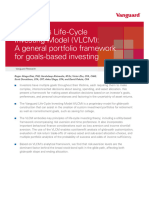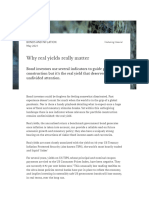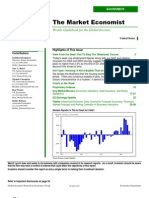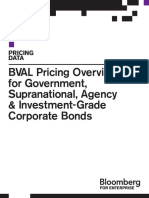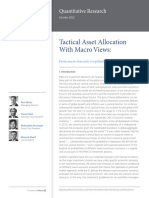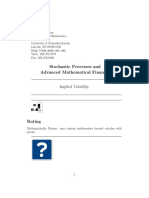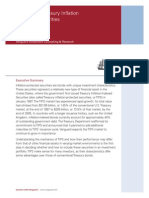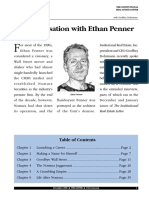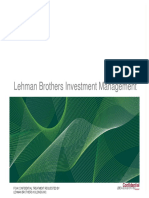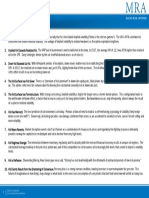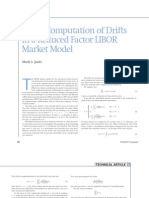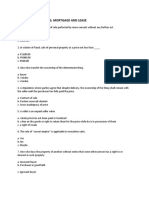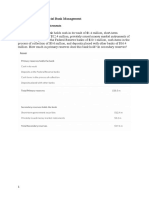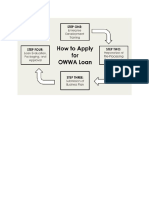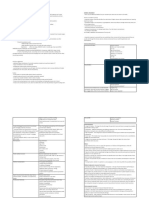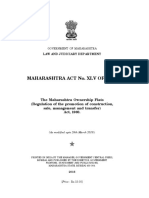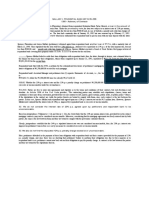Risk Management at Pim Co
Uploaded by
rpcampbellRisk Management at Pim Co
Uploaded by
rpcampbellQuarterly Review
F O U R T H Q U A R T E R 2 0 0 0
Risk Measurement at PIMCO
In June of 1998, we wrote “Measuring Risk in Bond Portfolios – A Primer”
to describe the important portfolio level risk metrics that PIMCO had
developed to measure and control risk in client portfolios. In that paper we
advocated separate measurement of the many risk factors impacting bond
portfolios, rather than the increasingly popular single measure approaches
such as VAR or tracking error. The ensuing months proved turbulent as
Russia defaulted and triggered extreme dislocation in global bond markets.
Correlations of most spread product soared, and players who invested on
the assumption that history would eventually repeat itself experienced
trouble, Long Term Capital being the most notorious. The robustness of
PIMCO’s risk metrics enabled us to endure that and subsequent volatile
periods relatively unscathed. Since risk measurement is a continually
evolving field, we would like to take this opportunity to update you on
our efforts.
Vineer Bhansali is the new head of domestic analytics at PIMCO. He
joined us early in 2000 to assume many of Pasi Hamalainen’s responsibili-
ties, in anticipation of Pasi’s move to Munich to head up portfolio manage-
ment there. Vineer is an Executive Vice President of PIMCO and a senior
member of PIMCO's portfolio management group. He was previously
associated with Credit Suisse First Boston, where he was Vice President of
proprietary fixed-income trading. Prior to that, he was a proprietary trader
for the Salomon Brothers arbitrage desk in New York and worked in the
global derivatives group at Citibank. He is the author of numerous
scientific and financial papers, and is the author of the book Pricing and
Inserts include:
Managing Exotic and Hybrid Options published by McGraw-Hill in 1998.
Current Strategy He currently serves as an associate editor for the International Journal of
Theoretical and Applied Finance. Vineer has ten years of investment experi-
Composite Performance
ence, and holds a bachelor’s and master’s degree in physics from the
California Institute of Technology, and a Ph.D. in theoretical particle
physics from Harvard University.
(continued inside)
Risk Measurement at PIMCO
Individual Security Level Valuation responds to innovation on Wall Street by creating new
and Risk Measurement Models risk measurement models for newly developed fixed
All portfolio level risk measures are simply an aggregation income instruments.
of the risks of each individual security held in a portfolio.
Therefore, accurate portfolio level risk measurement Measuring Benchmark Risk
depends on accurate individual security risk measurement. PIMCO computes the risk characteristics of all the major
PIMCO has developed a library of proprietary models to benchmarks used by our clients. In practice, this entails
value and measure risks in virtually every fixed income using the models listed above to analyze each and every
security type including: bond in large indices such as the Lehman Aggregate or the
Lehman Global Aggregate (6000+ securities), on a daily
n Government Bonds basis. The proprietary portfolio level risk measures that
(both domestic and international) we describe below are then computed for each benchmark,
n Corporate Bonds so that portfolio managers have targets against which they
(including callable and floating rate) can manage portfolios. Frequently our proprietary
n MBS pass-throughs and CMOs systems identify risks (such as effective durations for
(includes our own proprietary mortgages) that are different from the index provider’s
mortgage prepayment models)
own values, and we can use those insights to enhance
n ARMs
performance and lower the tracking error of our portfolios.
n FHA loans
On any given day, we are re-computing the risk measures
n Danish Mortgages using our own analytics for more than 500 primary and
n Futures secondary benchmarks.
n Options/Options on Futures
n Municipal Bonds Interest Rate Risk
n Convertible Bonds Until 15 or 20 years ago, average maturity was used to
n Interest Rate Swaps and Options gauge a portfolio’s price sensitivity to changes in interest
n Default Swaps and Asset Swaps rates. Maturity’s major shortcoming – only considering a
n High Yield bond’s final due date, and not the dates of the intervening
n Emerging markets cashflows – is now well understood. Effective duration,
n TIPS which does consider all cashflows, is now the standard
n Foreign Currency forwards way to measure interest rate risk. However, duration,
and Options while useful, has its shortcomings too, and must be
n Short term futures and options augmented with other measures of interest rate risk:
(Fed Funds, Eurodollars)
n Equity Index Futures and Options Effective Duration – Effective duration is a weighted
average maturity calculation that incorporates all of a
bond’s expected cashflows, and weights them according
These relative value and risk models are designed to to the present value of each cashflow. It is used to measure
permit stress testing of all embedded assumptions in order a bond’s price sensitivity to changes in interest rates.
to provide portfolio managers with the widest spectrum of However, it is only an accurate predictor of price for small,
outcomes, from very likely to most unlikely. Our models parallel shifts in the yield curve. For a small parallel
are unbiased by PIMCO’s market views, and where interest rate fluctuation, the percentage change in a bond’s
possible, we allow for calibration of important variables price is approximately equal to its duration multiplied by
such as volatility and future interest rates using traded the size of the shift. For example, a portfolio with a
security prices. We embed a common interest rate or term duration of 2 years would be expected to go up in price by
structure model in all our analytics, so that all our risk 2 basis points for every 1 basis point drop in interest rates.
measures are comparable across sectors and can be
legitimately aggregated. The Financial Engineering Group, Effective Convexity – When moderate to large changes in
led by Vineer, continually upgrades PIMCO models to interest rates occur, effective duration cannot accurately
reflect the latest advances in theoretical finance and predict the change in value of a bond because its duration
2 Q UA RT E R LY R E V I E W
Risk Measurement at PIMCO
will change. The duration of an option free bond, such PIMCO’s security specific models is designed to reflect
as a treasury, will increase as rates fall and decrease as real world behavior, and are therefore not exposed to the
rates rise because the discount rate used in the duration erroneous assumptions of the standard convexity calculation.
calculation falls and rises, respectively. Convexity
While PIMCO typically uses shock scenarios of plus or
captures the price effect resulting from the duration
minus 50 basis points, we have the ability to run scenarios
change. Positive convexity is always favorable to bond
of different magnitudes. A portfolio with a +50 Bear
investors, however, one can rarely get it for free – investors
Duration of 5 years, versus an effective duration of 4.5
generally pay for positive convexity by accepting lower yields.
years, tells the portfolio manager the portfolio is exposed
The duration of a mortgage security will increase as rates to extension risk. An effective portfolio convexity
rise because prepayments will be slower than originally calculation would not usually measure that risk accurately.
assumed, swamping the favorable impact of the change in
the discount rate. Conversely, in a bull market, when Yield Curve Risk Measures
interest rates fall, a mortgage will generally become shorter Yield curve risk gauges price exposure to non-parallel
in duration because prepayments will speed up. This shifts in the yield curve. It is critical to evaluate yield curve
perverse characteristic of becoming longer in bear markets exposure because two portfolios with identical effective
and shorter in bull markets is referred to as negative durations can perform very differently. For example, a 5
convexity, and is the main reason why mortgage investors year duration portfolio that contains only 5 year duration
are paid higher yields than treasuries, which have similar bonds (called a bullet structure) can perform very
credit quality. differently from a 5 year duration portfolio that contains
50% cash and 50% 10 year duration bonds (called a
For non-optionable securities, the calculation of convexity
barbell). Barbelled portfolios will typically outperform
includes the simple discounting of known, fixed cashflows.
bulleted portfolios if the yield curve flattens (spreads of
However, for mortgages and other optionable bonds, the
long rates narrow relative to short rates), and vice-versa.
calculation of convexity is not so simple because it involves
PIMCO measures and monitors yield curve exposure with
behavioral assumptions (e.g. future prepayment patterns).
the following tools:
Moreover, convexity assumes that duration extension or
contraction in response to interest rate changes is Curve Durations – Empirical evidence suggests that more
symmetrical. In other words, the change in duration than 95% of the fluctuations of the yield curve can be
induced by a rise in rates, will be identical in magnitude described in terms of parallel shifts and twists. PIMCO
(though opposite in direction) to the change induced by tries to capture the effect of these two factors with our
a similar fall in rates. In the real world, optionable bonds curve duration risk measures. We assume the 10 year
rarely exhibit symmetry. point of the curve as the pivot point, and then our
2-10 Duration measures the price sensitivity of a portfolio
Bull and Bear Market Durations – Because of the
to a steepening or flattening in the 2 to 10 year part of the
shortcomings of effective convexity, PIMCO’s risk
curve, while our 10-30 Duration measures the impact of
management process does not rely on the common
changes to the slope of the 10 to 30 year part of the curve.
approach of using a combination of effective duration and
effective convexity to predict the response of our portfolios However, since no single measure can accurately capture
to a large parallel shift in interest rates. Instead, we have all the curve exposure in our portfolios, we also decompose
developed proprietary measures known as bull and bear our exposures along the yield curve into multiple duration
market durations. To calculate these durations, we shock classification matrices.
the portfolio with a 50 basis point rise and 50 basis point
Duration Classification Matrices – Each holding within a
drop in rates. Each security in our portfolios is then
PIMCO portfolio is individually analyzed daily in order to
individually re-analyzed using the appropriate security
populate a variety of duration classification matrices. We
valuation tool (e.g. our adjustable rate mortgage model,
can also create a similar matrix for any client benchmarks,
our mortgage pass-through model or our callable corporate
as shown for the Lehman Aggregate Index on the next
bond model), to calculate the expected duration under the
page. The matrix sorts the portfolio or benchmark into
“shock” scenarios. Those durations are then averaged to
“duration buckets” that can be customized by the user.
arrive at the portfolio bull and bear durations. Each of
Q U A RT E R LY R E V I E W 3
Risk Measurement at PIMCO
Duration Weighted Exposure (Years) Lehman Aggregate Index as of 12/31/00
<0 0 to 1 1 to 3 3 to 5 5 to 7 7 to 8 8 to 11 11+ Total
Treasury/Tsy Future 0.00 0.00 0.12 0.28 0.25 0.05 0.37 0.46 1.54
Agencies/Swaps 0.00 0.01 0.09 0.17 0.03 0.00 0.18 0.17 0.65
GNMA Mtg/CMOs 0.00 0.01 0.11 0.11 0.00 0.00 0.00 0.00 0.23
Conventional Mtges/CMOs 0.00 0.01 0.25 0.53 0.00 0.00 0.00 0.00 0.79
NonAgency Mtges/CMOs 0.00 0.00 0.00 0.03 0.05 0.00 0.00 0.00 0.07
Corporates 0.00 0.01 0.13 0.09 0.36 0.06 0.34 0.25 1.24
High Yield 0.00 0.00 0.00 0.00 0.00 0.00 0.03 0.00 0.03
Emerging Markets 0.00 0.00 0.00 0.00 0.00 0.00 0.00 0.00 0.00
0.00 0.03 0.70 1.21 0.70 0.11 0.92 0.88 4.54
The matrix can be run on a market value weighted basis, a all else being equal, a portfolio with a volatility duration
duration weighted basis or using one of our sector risk of 0.1 would be expected to decline 10 basis points for
measures, enabling portfolios managers greater insight every 1% (or 100 basis point) rise in interest rate volatility.
into the nature of their exposure along the yield curve. To
Mortgage Spread Duration – Option adjusted spread
drill deeper, portfolio managers can click on any cell in the
(OAS) is the net spread over the Treasury curve that
matrix and identify all the individual securities that
optionable securities offer, in addition to compensating
contribute to that cell.
for the embedded option. For example, a current coupon
GNMA may have a nominal yield spread of 150 basis
Sector Exposure
points over similar duration Treasuries, but analysis of the
Sector Classification Matrix – Just as the classification
prepayment option embedded in the GNMA values it at 50
matrix is used to depict portfolio exposure along the yield
basis points, so the OAS would be 100 (150-50). When
curve, it also shows portfolio exposure to each sector. The
interest rate volatility rises, the value of the option will
sample matrix above shows eight different sector buckets,
increase, pushing spreads wider, but the OAS may stay the
but portfolio managers have unlimited ability to customize
same. The OAS demanded by investors tends to be more
them. This enables PIMCO’s mortgage specialist, for
stable than the nominal spread, but it does vary with
example, to drill deeper into our mortgage holdings by
market conditions. PIMCO’s mortgage spread duration
defining finer slices. A sample matrix with more sector
gauges the price sensitivity of a portfolio to changes in the
detail is shown on the following page.
OAS for mortgages, all other things being equal. If OAS
While the matrix provides in-depth insight into the across all mortgage sectors increased by 1 basis point, a
distribution of our sector allocations, there is still a need portfolio with a mortgage spread duration of 1 would be
for summary risk measures that gauge a portfolio’s expected to lose 1 basis point, all other things being equal.
sensitivity to the important sector related performance
Prepayment Duration – When analyzing mortgage
variables.
securities, calculation of the volatility duration and spread
Volatility Duration – Fixed income securities that contain duration involve forecasting future prepayment patterns
embedded options, including all mortgages and most for each type of mortgage security. Prepayment
corporates, are exposed to interest rate volatility risk. That forecasting has evolved into a very complex science,
is, a rise or fall in interest rate volatility will impact the and we have developed our own proprietary prepayment
price of a bond with embedded options. Volatility duration models that capture short term fluctuations and long term
is computed by shocking the implied volatility in the trends of prepayments based on our macroeconomic
common underlying term structure model embedded in all forecasts. To know the impact on our portfolios of an
our analytics by 1%, thus arriving at a risk measure that is unforeseen change in prepayments, we shock the
comparable across sectors. We cumulate the results from parameters of our models to gauge the effect of faster
analyzing individual securities in a portfolio to arrive at a or slower prepayments.
portfolio level sensitivity measure that predicts the price
Corporate Spread Duration – PIMCO’s corporate spread
impact resulting from changes in volatility. For example,
duration, similar to our mortgage spread duration,
4 Q UA RT E R LY R E V I E W
Risk Measurement at PIMCO
measures a portfolio’s overall price sensitivity to changes in PIMCO. For example, commercial mortgage backed
corporate OAS. Corporate and mortgage spread durations security (CMBS) analysis involves both the credit team and
need to be calculated separately because different factors the mortgage team, who undertake the structural cashflow
impact spreads in those sectors, and therefore, they can analysis. In assessing sovereign credit risk, our
behave differently from one and other. Similarly, spreads international group plays a leading role.
of differently rated bonds do not move in perfect synch, so
Credit risk at the portfolio level is tracked in two ways:
our corporate spread duration model adjusts for this by
refreshing the rating “betas” embedded in our model on a Duration Weighted Average Credit Quality – Investors
quarterly basis to reflect current market conditions. often look to an average credit quality statistic, calculated
using market value weights, to give them a snapshot of
Other Sector Spread Durations – As our participation in
their portfolio’s quality profile. However, a market value
the universe of fixed income securities grows, we have
weighted approach fails to recognize that the credit risk
stuck to our desire to develop rigorous models for each
imparted by short duration securities is less than for
market we invest in. To achieve this, we have developed
identical quality long duration ones. This is because one
new models for valuation and risk management of
can predict an issuer’s financial performance over shorter
emerging markets, inflation protected securities (TIPS),
horizons with greater confidence. Moreover, if an issuer’s
municipal bonds and convertible bonds. To capture the
credit quality does deteriorate and its yield spread widens,
risks due to the specific factors that affect the relative value
the detrimental price impact on shorter bonds is more
of these bonds, we have added EM, TIPS, muni and
muted than on longer bonds. By calculating average
convertible spread durations to our risk management arsenal.
quality on a duration weighted basis, PIMCO is able to get
a much truer picture of a portfolio's overall exposure to
Credit Risk
credit risk.
Measuring credit risk is more art than science, but PIMCO
is equally rigorous in this area. We rely on in-house Quality Matrices – An average quality statistic, whether
research, rather than the rating agencies, for assessing duration weighted or not, does not impart any information
credit risk. Our staff of seasoned credit analysts rate every about quality distribution within a portfolio. For example,
credit held in our portfolios. Our analysts specialize by a portfolio comprised 50% of BB rated bonds and 50%
industry, and in many cases, have covered particular AAA rated bonds would have the same average quality
industries and issuers for a decade or more. rating, single A, as a portfolio comprised of only A rated
bonds. To get a clearer picture of quality distribution, we
For non-corporate issues that have an element of credit
have created matrices that show quality distribution across
risk, we marshal the resources of other departments within
sector, industry and yield curve buckets.
Duration Weighted Exposure (Years) Lehman Aggregate Index 12/31/00
sector_desc <0 0<1 1<3 3<5 5<7 7<8 8<11 11+ Total
ABS 0.00 0.00 0.00 0.01 0.00 0.00 0.00 0.00 0.01
AGCY 0.00 0.01 0.09 0.17 0.03 0.00 0.18 0.17 0.65
CORP-A 0.00 0.00 0.04 0.06 0.22 0.01 0.14 0.11 0.59
CORP-AA 0.00 0.00 0.04 0.02 0.05 0.00 0.04 0.02 0.18
CORP-AAA 0.00 0.00 0.00 0.00 0.02 0.02 0.02 0.00 0.06
CORP-B 0.00 0.00 0.00 0.00 0.00 0.00 0.03 0.00 0.03
CORP-BB 0.00 0.00 0.00 0.00 0.00 0.00 0.00 0.00 0.00
CORP-BBB 0.00 0.00 0.05 0.01 0.07 0.04 0.14 0.11 0.41
EmMkt-A 0.00 0.00 0.00 0.00 0.00 0.00 0.00 0.00 0.00
FHLMC-PT 0.00 0.00 0.12 0.23 0.00 0.00 0.00 0.00 0.35
FNMA-PT 0.00 0.00 0.13 0.30 0.00 0.00 0.00 0.00 0.44
GNMA-PT 0.00 0.01 0.11 0.11 0.00 0.00 0.00 0.00 0.23
NONAGY-CMO 0.00 0.00 0.00 0.01 0.05 0.00 0.00 0.00 0.06
TSY 0.00 0.00 0.12 0.28 0.25 0.05 0.37 0.46 1.54
0.00 0.03 0.70 1.21 0.70 0.11 0.92 0.88 4.54
Q U A RT E R LY R E V I E W 5
Risk Measurement at PIMCO
Total PIMCO Exposure Report – Credit exposure at the to deteriorating liquidity is controlled largely by adhering
firm level is also monitored closely because of liquidity to relatively conservative diversification and maximum
considerations. While we adhere to prudent diversification exposure guidelines.
standards within each portfolio, a high level of exposure
to a particular issuer across all PIMCO portfolios could Tracking Error
present trouble in the event of illiquid market conditions. Expected tracking error ventures to predict how well a
portfolio will track its benchmark. It is the annualized
Counterparty Risk Report – Given our frequent use
expected standard deviation of the monthly return
of swaps and forward settled trades to generate excess
difference between the portfolio and the benchmark.
returns and minimize risk, it becomes important that
For example, if the expected tracking error is 1.2, then the
we manage our exposures to specific counterparties.
yearly portfolio return is expected to be within 120 basis
A counterparty risk management system that provides
points of the expected return two thirds of the time, and
detailed exposures to counterparties, broken down by the
within 240 basis points 19 out of 20 times. As mentioned
different types of outstanding trades, is used for actively
earlier, PIMCO does not advocate the use of a single risk
monitoring counterparty exposure.
metric as an alternative to our more robust approach of
separately tracking multiple metrics that measure the
Global Risk Measures
many sources of risk in a bond portfolio. However, we do
The portfolio risk measures described above are available
use an expected tracking error model to supplement our
for both U.S. and non-U.S. portfolios. In the case of most
insight into portfolio allocations versus benchmark, both
non-U.S. securities, the models embedded in our risk
domestically and globally. Our tracking error model
measures, such as term structure and prepayment models,
overcomes the obvious shortcomings of most VAR or
have had to be adapted to the nuances of specific countries.
tracking error models in two ways. First, it can be run with
Global Exposures Matrices – The risk of a non-U.S.bond both historical and forecast variance-covariance matrices.
can be separated into two related components – the Second and most important, it is run against the
country or region risk (exposure to changes in foreign comprehensive menu of proprietary portfolio risk metrics
interest rates) and the currency risk. As with yield curve, described above (duration, curve durations, spread durations,
sector, and credit risk, it is difficult to quantify these risks etc.) instead of against individual portfolio holdings. Because
with just one measure. Therefore, PIMCO’s customizable our risk metrics are aggregated at the portfolio level, they are
global exposures matrix aggregates all holdings by country much smoother over time, making the validity of results from
and currency, sector and yield curve, etc. We also enable our tracking error model more robust.
portfolio managers to create groupings of regions and
countries to identify correlated concentrations of risk. Conclusion
Measurement and management of overall portfolio risk
Liquidity Risk is a major effort at PIMCO. It involves all portfolio
The degree of liquidity in a portfolio is managed carefully managers, who interact with our Financial Engineering
by PIMCO Portfolio Managers, subject to client investment Group to ensure that the models they develop are not
guidelines and liquidity needs. Most PIMCO clients are only theoretically sound, but also reflect market realities.
long-term investors, so they typically do not have It involves a “technology workbench” of seasoned
significant liquidity needs. Therefore, the purchase of programmers who help to upgrade existing models
relatively less liquid securities may be warranted due to and implement new ones. And it involves many other
the higher yield (often called liquidity premium) that less technologists who work to integrate our risk measurement
liquid issues offer. PIMCO monitors near term liquidity tools with our other PIMCO systems, including
needs and manages cash optimally using a proprietary accounting, compliance and client reporting. The scope
model that incorporates exposure to unsettled trades, as and cost of this effort is huge, but it has helped enable
well as futures and swaps. The risk of having exposure to PIMCO to avoid inadvertently introducing unwanted
sectors that have the potential to lose significant value due risks into our clients’ portfolios.
6 Q UA RT E R LY R E V I E W
Assets Under Management
DOMESTIC Assets Managed Account Minimum
FIXED INCOME Benchmark Average Duration (mm) Pooled Separate
Total Return* Lehman Aggregate 3 to 6 years $116,932 $5 mm $75 mm
Low Duration* Merrill Lynch 1-3 Yr. U.S. Tsy. 1 to 3 years 7,634 5 mm 75 mm
Moderate Duration* Lehman Inter. Gov’t. / Credit 2.5 to 4.5 years 4,194 5 mm 75 mm
Short-Term* Salomon 1 Year Tsy. 1 year maximum 4,723 5 mm 75 mm
Long Duration* LB Long Gov’t./Credit Client Specific 17,957 5 mm 75 mm
Mortgage* Salomon Mortgage Index Duration 7,735 5 mm 75 mm
High Yield* LB Inter.BB U.S. High Yield Index Duration 9,900 5 mm 75 mm
Stable Value* Various GIC Indices Client Specific 7,873 5 mm 75 mm
Real Return* Lehman Inflation-Linked 1 to 5 years 1,730 5 mm 75 mm
Municipal Bonds* Lehman General Municipal 0 to 10 years 374 5 mm 25 mm
Convertible Bonds* Convertible First Boston Convertible 316 5 mm 25 mm
INTERNATIONAL Assets Managed Account Minimum
FIXED INCOME Benchmark (mm) Pooled Separate
Global Unhedged* Sal. World or J.P. Morgan Global Gov’t. - Unhedged $ 2,266 $5 mm $75 mm
Global Hedged* Sal. World or J.P. Morgan Global Gov’t. - Hedged 4,881 5 mm 75 mm
Non-U.S. Unhedged Sal. World or J.P. Morgan Gov’t Bond, Non-U.S.- Unhedged 756 n.a. 75 mm
Non-U.S. Hedged* Sal. World or J.P. Morgan Non-U.S. Gov’t.- Hedged 3,465 5 mm 75 mm
Global Short-Term 3-Month LIBOR 24 n.a. 75 mm
European Hedged Sal. Euro Broad Investment Grade 4 2 mm 75 mm
Canadian RBC DS Canadian 215 n.a. 75 mm
Australian Warburg Dillion Read AUD Composite 366 n.a. 75 mm
Emerging Markets* J.P. Morgan Emerging Markets Brady Plus 341 5 mm 50 mm
Assets Managed Account Minimum
EQUITY/BALANCED Style Benchmark (mm) Pooled Separate
StocksPLUS* Enhanced Index S&P 500 $18,761 $5 mm $100 mm
Strategic Balanced* Balanced Lipper Balanced 69 5 mm 100 mm
* Product available through PIMCO Funds, a family of open-end mutual funds. Total Return, Money Market, High Yield, Global, European,
and StocksPLUS products also available through off-shore mutual funds.
CURRENT STAFF AT PIMCO: TOTAL PIMCO ASSETS: $216 BILLION
- 6 Executive Management
- 44 Portfolio Management PIMCO SPECIALTY MARKETS: $23 BILLION
- 74 Account Management and Marketing
- 230 Technical and Administrative
Total 354
Recent Developments
n Bill Gross and his team were named “Fixed Income Manager of the n Phil Hart, Yiannis Repoulis, and Ramon Maronilla joined the Account
Year” for 2000 by Morningstar, making PIMCO the only two-time Management Group during the quarter. They will be working in our
winner in Morningstar history. PIMCO last won the award in 1998. Australian, London, and Singapore offices, respectively.
Morningstar noted “PIMCO’s strong performance doesn’t just reflect n Lee Thomas has focused his responsibilities as Head Non-U.S.
good calls, it reflects the team’s success with risk controls that keep Strategist, delegating his day-to-day portfolio management
portfolios from making dangerous bets.” responsibilities to other members of PIMCO’s 11-person global team.
n PIMCO’s marketing group announced the creation of a dedicated This shift will enable Lee more time for research and client contact.
Consultant Relations Group. The new structure recognizes the n Kendall Miller recently became a member of PIMCO’s Non-U.S.
importance of consultants to PIMCO’s business. It will be headed Portfolio Management team. He joined the firm four years ago as a
by Managing Director Margaret Isberg and include Michael Dow, quantitative/research analyst developing risk management applications
Ray Hayes, Tom Kelleher, Marcy Rappaport, and Mark Romano. and models as well as mortgage-backed trading applications.
n PIMCO has officially opened its New York Office. Account Managers n David Hinman transferred to the Portfolio Management group as a
Teri Frisch, Scott Millimet, Tom Otterbein and Seth Ruthen are now corporate credit specialist. Previously, David had served both as an
based there, as is convertible portfolio manager Sandra Durn. Account Manager and as Product Manager for PIMCO’s credit-related
n Portfolio Manager Paul McCulley was named Managing Director in products including High Yield and CDOs.
December. Paul, a Federal Reserve specialist and key member of n Executive Vice President Ben Ehlert, a senior credit analyst and 30-
PIMCO’s investment committee, is a frequent public spokesperson year veteran of PIMCO and Pacific Life, relocated to his Colorado
for PIMCO’s investment outlook. home and will now be a part-time consultant to PIMCO’s credit team.
n Jeff Ludwig recently joined the firm as Vice President and portfolio n PIMCO is sponsoring a global investing essay contest with a grand
manager, with responsibilities in the areas of equity derivatives, prize of $5,000. We will invite university students, faculty members,
hedged products, and domestic analytics. He previously served as professionals and practitioners to submit essays of up to 2,000 words.
Vice President for Credit Suisse First Boston in New York as a Please see back page for more details.
proprietary equity derivatives trader, specializing in quantitative
arbitrage strategies in the U.S. and Europe. (please see back page for brief biographies of all new professionals)
Q U A RT E R LY R E V I E W 7
U.S. Strategy
Global Economic Growth To Slow Sharply, n We expect protracted Fed easing as the economy
Led By U.S. slows, while Federal budget surpluses also provide
Global growth will decelerate sharply as a U.S. slow- room for fiscal stimulus. These effects will, however,
down spills over into other developed and emerging arrive with a lag over the next 12 to 18 months.
economies. The landing will be hardest in the U.S.,
n A cyclical drag created by microeconomic restruc-
where previously exuberant investment and consumer
turing makes Japan especially vulnerable to
spending will slow substantially. Tentative recovery in
spillover from the U.S. Still, reforms such as
Japan will evaporate in the face of reduced demand for
allowing more bankruptcies will provide macro-
Japanese exports from the rest of Asia and the U.S.
economic benefits for Japan in the long run.
Europe will land more softly, cushioned by more limited
export ties to the U.S. and the absence of investment n A terms of trade shock from last year's surge
and consumption bubbles. in oil prices will help curtail growth in Euroland.
Exacerbated by a weak euro, this shock is producing
n The investment spending boom that fueled the
a decline in real wages that will depress aggregate
rapidly growing New Economy has been self-
demand.
justifying until recently. Investment in productivity-
enhancing information technology boosted n Inflation in the U.S. and Euroland will decline over
profitability and returns, begetting higher asset the next several quarters as oil prices move lower.
values and lower capital costs, prompting still Slower worldwide growth and the end of cold winter
more investment. weather will reduce price pressure in the oil market.
n This virtuous circle is now reversing itself. Reduced
earnings growth and concern about high levels of
Managing Credit and Refinancing Risk
corporate debt produced a dramatic repricing of
Will Be Critical
Emphasis on high quality assets will continue to be
risk in stock, corporate bond and bank loan markets
rewarded as the economy slows and credit quality
in 2000. Heightened risk aversion among suppliers
comes under increasing pressure. Top-tier agency and
of capital, combined with lower profits and returns
corporate issues with short maturities are reasonable
as the economy cools, point to a sharp slowdown in
alternatives in this environment. While longer dated
investment spending.
corporates and emerging market bonds offer higher
n The U.S. consumption binge will slow along with yield premiums, they are also more vulnerable to adverse
investment as confidence erodes further. Softer price performance as global growth slows. Mortgages are
equity markets mean that consumers can no longer another high quality alternative, but mortgage investors
count on capital gains to supplement disposable will face greater refinancing risk as decelerating growth
income. Slowing corporate profits translate into puts a ceiling on interest rates. Increasing the portfolio's
more insecurity about future income and employment. overall interest rate sensitivity, or duration is one way to
offset heightened refinancing risk.
n Stability in the housing sector will partially offset
weaker investment and consumer spending.
Lower mortgage rates will stimulate housing starts,
boosting sectors of the economy related to housing,
such as consumer durables.
8 Q UA R T E R LY R E V I E W
Global Strategy
Global Economic Growth to Decelerate Sharply indebted developed nation, with debt as a percentage of
The pace of global growth will decelerate sharply, led GDP over 120 percent. For this reason, we will continue
by the U.S. economy. Global inflation will also decline to underweight Japan.
as slower worldwide growth reduces price pressure,
particularly in commodities. The U.S. slowdown will Dollar-Bloc
be hardest, as investment and consumer spending slow In the U.S., we expect bonds to continue to rally as the
substantially. The European landing will be softer, Fed cuts rates amid a slowing economy. Heightened risk
cushioned by 2001 tax cuts. Prospects for economic aversion among suppliers of capital, combined with
recovery in Japan will be hampered by low consumer lower profits and returns as the economy cools, point
confidence, banking system weakness and an expected to a sharp slowdown in investment spending. Consump-
reduction in investment spending. tion will slow as confidence falls further. Softer equity
markets mean that consumers can no longer count on
Europe capital gains to supplement disposable income. Re-
We continue to see a good environment for bonds in duced corporate profits will result in more insecurity
core Europe. Headline inflation has peaked and core about future income and employment.
inflation will remain stable, below two percent. High
Elsewhere in the dollar-bloc, we expect the Canadian
grade European bonds should outperform, given weak
economy to follow the U.S., but with a lag. Domestic
equity markets and continued deterioration in credit
demand will be supported by new spending initiatives
quality. In Europe we will:
of the recently re-elected Liberal Party. Canada's low
n Overweight core Europe, as slowing global growth bond yields relative to the U.S. continue to make this
will cause bond prices to rally. market unattractive. Australian growth will slow amid
eroding business and consumer confidence, but growth
n Hold shorter maturity bonds in core Europe as the
in exports fueled by a weak currency will cushion this
slowdown in global growth will allow the European
impact. New Zealand's economic recovery will con-
Central Bank to begin lowering short-term rates.
tinue, but weaker global growth will cause the Reserve
n Underweight the U.K. We believe market expecta- Bank to begin reducing rates from 6.5 percent during
tions for U.K. yields trading below German yields the first quarter. In the dollar-bloc, we will:
are incorrect, given prospects for tighter labor
n Underweight Canada due to unattractive yields
markets and rising inflation in the U.K.
and risks that new spending measures will turn
n Take positions that will benefit from widening of the fiscal surplus into a deficit.
corporate yield premiums due to increased corporate
n Focus on U.S. mortgages, where credit risk is
issuance and reduced government bond supply.
minimal and attractive yield premiums provide
n Overweight the euro versus the U.S. dollar. Rela- a cushion against adverse price performance.
tively slower U.S. growth, worries over the U.S.
n Hold select top-quality corporate issues, focusing
current account deficit and further European
on short maturities, given our concern about
structural reforms will bolster the euro.
eroding credit quality amid slower growth.
Japan n Emphasize real return bonds as weaker growth will
Weak bank balance sheets, ongoing corporate restruc- put continued downward pressure on real yields.
turing and the global economic slowdown will limit
Japanese growth. The deteriorating fiscal situation will Emerging Markets
weigh heavily on this market as government bond Where permitted, we will maintain a small emerging
issuance continues to increase. Credit fundamentals market position, favoring higher-quality credits such as
will deteriorate as Japan remains the most heavily Mexico, Hungary, Poland and South Korea. Our focus
will continue to be on highly liquid, shorter-maturity
instruments.
QU A RT E R LY R E V I E W 9
New Professionals
Portfolio Management Account Management
Jeffrey Ludwig Phillip P. Hart
Mr. Ludwig is a Vice President and portfolio manager, with Mr. Hart is a Vice President and account manager. He recently joined
responsibilities in the areas of equity derivatives, hedged products, the firm to manage existing client relationships in Australia and New
and domestic analytics. Mr. Ludwig recently joined the firm, having Zealand. Previously, he represented Global Cash Management for
previously served as Vice President for Credit Suisse First Boston in State Street Bank & Trust in Asia where he was responsible for fund
New York as a proprietary equity derivatives trader, specializing in manager and pension fund clients in interest rate products and
quantitative arbitrage strategies in the U.S. and Europe. He has four banking e-commerce systems. Prior to that, he held a sales and
years of investment experience, and holds a bachelor's degree in structuring role at one of Australia's leading banks Westpac,
Aeronautics and Astronautics and a master's degree and Ph.D. in specializing in fixed income and foreign exchange products for
electrical engineering and computer science, all from the institutional clients. He has eleven years of investment experience.
Massachusetts Institute of Technology. He served thirteen years in the Royal Australian Navy and holds a
Bachelor of Science degree from the University of New South Wales
and an MBA from the University of Adelaide.
Global Investing Essay Contest Ramon F. Maronilla
Mr. Maronilla is an account manager for the PIMCO Asia Pte. Ltd
PIMCO will sponsor an essay contest on global investing with
office in Singapore. He is responsible for servicing PIMCO's client
a grand prize of $5,000. This contest will allow us to tap into relationships in the Asia ex-Japan region. Mr. Maronilla joined the
new investment ideas and raise awareness about the global firm in 2000, having been previously associated with Goldstein
transformation of fixed income investing. We are inviting Capital Corp, a hedge fund in New York City, and Citibank in Manila.
He has over three years of investment experience, and holds a
university students, faculty members, professionals and
bachelor's degree in Economics from the University of the
practitioners to submit essays of up to 2,000 words on topics Philippines and an MBA in Finance from Columbia University
such as global investment economics, multi-currency asset Graduate School of Business.
allocation and crisis dynamics/management. Besides the grand Yiannis D. Repoulis
prize, winners in each of four categories undergraduate, Mr. Repoulis is an account manager. He joined the firm in 1998, and
masters and doctoral level plus faculty members/practitioners focuses on building PIMCO's client servicing efforts in Europe. Prior
to joining PIMCO Europe Ltd’s Lon-don office, Mr. Repoulis was
will receive $1,000 prizes. Bill Gross will chair the essay contest
associated with EFG Private Bank. He holds a bachelor's degree in
selection committee. The panel of judges will also include Alberto economics and a master's degree in international political economy
Giovanni, Deputy General Manager of Banca di Roma and former from the London School of Economics, and an MBA from the J.L.
Ministry Chairman of the Italian Treasury; and Peter L. Bernstein, Kellogg Graduate School
of Management.
President of Peter L. Bernstein Inc. Essays must be received by
PIMCO on or before June 1, 2001. Please visit our site at
www.pimco.com/contest to submit your essays.
This information is intended solely to report on investment strategies and opportunities identified by PIMCO. Opinions and estimates offered constitute our judgment and
are subject to change without notice, as are statements of financial market trends, which are based on current market conditions. We believe the information provided here is
reliable, but do not warrant its accuracy or completeness. This material is not intended as an offer or solicitation for the purchase or sale of any financial instrument. Please
note that investments in non-U.S. securities and markets pose different and possibly greater risk than those customarily associated with domestic securities, including
currency fluctuations, non-U.S. taxes and political and economic instability. The views and strategies described may not be suitable for all investors. This material has been
prepared for informational purposes only, and is not intended to provide, and should not be relied on for, accounting, legal or tax advice. You should consult your tax or legal
advisor regarding such matters. Please contact your account manager for further information.
Copyright 2001, PIMCO.
840 Newport Center Drive
Post Office Box 6430
Newport Beach
California 92658-6430
Tel: 949-720-6000
www.pimco.com QTREVIEW4Q00
Composite Performance
Periods Ended 12/31/00
10 Yrs.* 7 Yrs.* 5 Yrs.* 3 Yrs.* 1 Yr. 4Q2000
Total Return Fixed Income - Full Authority (%)1 9.51 7.78 7.61 7.07 12.16 4.48
- Net of Fees 9.21 7.50 7.34 6.81 11.89 4.42
Total Return Fixed Income - Medium Authority (%)2 9.23 7.47 7.22 6.97 12.29 4.63
- Net of Fees 8.98 7.23 6.99 6.74 12.06 4.58
Total Return Fixed Income - Limited Authority (%)3 8.83 7.36 7.06 6.93 12.63 4.59
- Net of Fees 8.57 7.12 6.83 6.72 12.39 4.54
Lehman Brothers Aggregate Bond Index 7.96 6.68 6.46 6..36 11.63 4.21
Moderate Duration Fixed Income - Full Authority (%)1 8.50 7.30 6.98 6.46 9.82 3.34
- Net of Fees 8.20 7.03 6.70 6.18 9.52 3.27
Moderate Duration Fixed Income - Medium Authority (%)2 – – 7.22 6.94 11.28 4.25
- Net of Fees – – 6.91 6.63 10.93 4.16
Moderate Duration Fixed Income - Limited Authority (%)3 – – 6.82 6.65 10.85 3.74
- Net of Fees – – 6.55 6.39 10.57 3.68
Lehman Brothers Intermediate Gov’t/Credit Index 7.35 6.17 6.11 6.22 10.10 3.70
Low Duration Fixed Income - Full Authority (%)1 7.82 6.91 7.02 6.39 8.14 2.22
- Net of Fees 7.38 6.50 6.68 6.09 7.85 2.14
Low Duration Fixed Income - Medium Authority (%)2 – 6.43 6.40 6.15 7.87 2.27
- Net of Fees – 6.16 6.13 5.87 7.59 2.21
Low Duration Fixed Income - Limited Authority (%)3 7.07 6.48 6.44 6.44 9.01 2.82
- Net of Fees 6.84 6.27 6.26 6.28 8.86 2.78
Merrill Lynch 1-3 Yr. Treasury Index 6.42 5.85 5.92 6.00 7.99 2.70
StocksPLUS Enhanced Equity - Full Authority (%)4 18.80 19.05 19.12 12.67 (8.35) (7.65)
- Net of Fees 18.40 18.75 18.87 12.50 (8.46) (7.70)
StocksPLUS Enhanced Equity- Medium Authority (%)5 – 18.66 18.69 12.51 (8.83) (8.16)
- Net of Fees – 18.44 18.51 12.37 (8.89) (8.19)
StocksPLUS Enhanced Equity - Limited Authority (%)6 18.38 18.65 18.75 12.56 (8.49) (7.66)
- Net of Fees 18.12 18.48 18.58 12.44 (8.57) (7.71)
S&P 500 Index 17.46 18.25 18.33 12.26 (9.11) (7.83)
7
Short-Term Fixed Income - Full Authority (%) 6.35 6.41 6.55 6.35 7.27 2.08
- Net of Fees 6.00 6.05 6.19 6.01 6.99 2.02
Short-Term Fixed Income - Limited Authority (%)8 – – 6.40 6.06 7.37 1.91
- Net of Fees – – 6.17 5.86 7.21 1.85
Salomon 1 Year Treasury Index 5.70 5.66 5.80 5.74 7.11 2.17
1
Full Authority includes accounts that allow each of the discretion types: futures or options, below investment grade and Int’l.
2
Medium Authority includes accounts that allow two of the three discretion types: futures or options, below investment grade or Int’l.
3
Limited Authority includes accounts that allow only one of the three discretion types: futures or options, below investment grade or Int’l.
4
Full Authority includes accounts that allow below investment grade.
5
Medium Authority includes accounts that allow Int’l.
6
Limited Authority includes accounts that do not allow below investment grade or Int’l.
7
Full Authority includes accounts that allow below investment grade.
8
Limited Authority includes accounts that do not allow below investment grade.
9
Full Authority includes accounts which allow at least 25% of the portfolio’s market value in non-mortgage type securities and allow below
investment grade and derivative type investments.
10
Limited Authority includes accounts which allow less than 25% of the portfolio’s market value in non-mortgage type securities or do not
allow below investment grade or derivative type investments.
11
These composites are currently comprised of one account, a U.S. registered mutual fund.
12
The Municipal Bond portfolio may be subject to state, local, and (if applicable) alternative minimum taxes.
Composite Performance
Periods Ended 12/31/00
10 Yrs.* 7 Yrs.* 5 Yrs.* 3 Yrs.* 1 Yr. 4Q 2000
Mortgage Fixed Income - Full Authority (%) 9 – – – 7.07 11.20 3.98
- Net of Fees – – – 6.72 10.85 3.90
Mortgage Fixed Income - Limited Authority (%)10 8.20 7.15 7.25 7.06 11.95 3.92
- Net of Fees 8.08 7.04 7.13 6.95 11.85 3.89
Salomon Mortgage Index 7.88 7.01 6.90 6.63 11.29 3.87
Global Hedged Fixed Income (%) – – 9.42 7.59 11.15 4.21
- Net of Fees – – 9.07 7.24 10.79 4.12
J.P. Morgan Global - Hedged Index 8.66 7.84 8.44 7.59 10.96 4.17
Global Unhedged Fixed Income (%) 8.58 6.52 4.58 4.35 2.32 3.72
- Net of Fees 8.25 6.21 4.31 4.09 2.09 3.66
Salomon World Gov’t. Bond Unhedged Index 6.99 5.13 3.10 3.89 1.60 4.30
Non-U.S. Hedged Fixed Income (%) – 9.27 10.38 7.58 10.31 3.80
- Net of Fees – 8.73 9.85 7.07 9.83 3.69
J.P. Morgan Gov’t. Bond Non-U.S., Hedged Index 8.98 8.47 9.49 8.02 9.71 3.73
Non-U.S. Unhedged Fixed Income (%) – 5.27 2.08 2.15 (2.46) 3.96
- Net of Fees – 5.05 1.87 1.96 (2.70) 3.89
Salomon World Gov’t., Non-U.S. Unhedged Index 6.78 4.65 1.64 2.87 (2.64) 4.00
High Yield Fixed Income (%) – 8.47 7.14 3.46 0.05 (1.47)
- Net of Fees – 7.93 6.64 3.01 (0.37) (1.57)
Lehman Brothers Interm. BB U.S. High Yield Index 10.14 7.30 6.41 3.88 3.73 (0.06)
Long-Term U.S. Government (%)11 – 9.07 8.33 8.44 20.98 8.10
- Net of Fees & Expenses – 8.53 7.79 7.90 20.38 7.97
Lehman Long Term Treasury Index 9.91 8.02 7.28 7.61 20.28 7.23
Strategic Balanced (%)11 – – – 10.18 (1.09) (1.65)
- Net of Fees & Expenses – – – 9.47 (1.73) (1.81)
60% S&P500 / 40% LBAG Index 13.79 13.75 13.78 10.29 (0.99) (3.07)
Real Return Full Authority (%)1 – – – 8.61 14.05 3.66
- Net of Fees & Expenses – – – 8.07 13.48 3.53
Lehman Inflation Linked Index – – – 6.39 13.18 3.79
Convertible Fund (%)11 – – – – (0.12) (10.23)
- Net of Fees & Expenses – – – – (0.77) (10.38)
First Boston Convertible Index 14.72 11.87 13.21 11.80 (7.83) (12.31)
Municipal Bond Fund (%)11 – – – 4.56 10.84 3.16
- Net of Fees & Expenses 12 – – – 4.04 10.29 3.03
Lehman General Municipal Index – 5.76 5.84 5.21 11.69 4.37
Emerging Markets Fund (%) – – – 9.50 15.58 2.59
- Net of Fees – – – 8.58 14.61 2.37
J.P. Morgan Emerging Markets + Index – 10.56 14.47 7.67 15.66 1.72
* Annualized. Past performance is no guarantee of future results. All performance figures reflect commissions, other expenses (except custody),
and reinvestment of earnings. The “net of fees” performance figures above also reflect the deduction of actual investment advisory fees.
You might also like
- India Strategy - Introducing GS India Equity Risk Barometer (GSSRIERB)100% (1)India Strategy - Introducing GS India Equity Risk Barometer (GSSRIERB)17 pages
- Clifford S. Ang - Applied Valuation - A Pragmatic Approach-De Gruyter (2023)100% (1)Clifford S. Ang - Applied Valuation - A Pragmatic Approach-De Gruyter (2023)234 pages
- Eduardo Epperlein - Risk Methodology Group - 14th NovNo ratings yetEduardo Epperlein - Risk Methodology Group - 14th Nov9 pages
- Vanguards Life Cycle Investing Model VLCM A General Portfolio Framework US ISGVLCM 032021 OnlineNo ratings yetVanguards Life Cycle Investing Model VLCM A General Portfolio Framework US ISGVLCM 032021 Online19 pages
- Why Real Yields Matter - Pictet Asset ManagementNo ratings yetWhy Real Yields Matter - Pictet Asset Management7 pages
- A Brief Comparison of Interpolation Methods in Yield Curve ConstructionNo ratings yetA Brief Comparison of Interpolation Methods in Yield Curve Construction3 pages
- L Evy Processes in Finance: A Remedy To The Non-Stationarity of Continuous MartingalesNo ratings yetL Evy Processes in Finance: A Remedy To The Non-Stationarity of Continuous Martingales10 pages
- Bloomberg 25 PortfolioAndRiskAnalytics 2049200No ratings yetBloomberg 25 PortfolioAndRiskAnalytics 20492009 pages
- Fixed Income Analysis: Duration-ConvexityNo ratings yetFixed Income Analysis: Duration-Convexity8 pages
- 2021-04-19-JPMorgan-Cross Asset Volatility What Can Option Implied S... - 92015012No ratings yet2021-04-19-JPMorgan-Cross Asset Volatility What Can Option Implied S... - 9201501211 pages
- Local and Stochastic Volatility: Johannes RufNo ratings yetLocal and Stochastic Volatility: Johannes Ruf62 pages
- Strong Headwind Warrants Caution in H1: European Investment StrategyNo ratings yetStrong Headwind Warrants Caution in H1: European Investment Strategy24 pages
- Tactical Asset Allocation With Macro Views:: Quantitative ResearchNo ratings yetTactical Asset Allocation With Macro Views:: Quantitative Research12 pages
- The Fundamentals of Fundamental Factor Models Jun2010No ratings yetThe Fundamentals of Fundamental Factor Models Jun201015 pages
- ETF Trading Strategy: For Accredited Investors (AI) And/or Professional Investors (PI) ONLYNo ratings yetETF Trading Strategy: For Accredited Investors (AI) And/or Professional Investors (PI) ONLY3 pages
- Valuations Suggest Extremely Overvalued MarketNo ratings yetValuations Suggest Extremely Overvalued Market9 pages
- Are Hedge Funds Becoming Regular Asset Managers or Are Regular Managers Pretending To Be Hedge Funds?No ratings yetAre Hedge Funds Becoming Regular Asset Managers or Are Regular Managers Pretending To Be Hedge Funds?45 pages
- 2001.01.06 - Elliott Wave Theorist - Bear Market StrategiesNo ratings yet2001.01.06 - Elliott Wave Theorist - Bear Market Strategies3 pages
- The Value of Intraday Prices and Volume Using Volatility-Based Trading StrategiesNo ratings yetThe Value of Intraday Prices and Volume Using Volatility-Based Trading Strategies40 pages
- Hedge Fund Risk Modeling: Miguel Alvarez Mike LevinsonNo ratings yetHedge Fund Risk Modeling: Miguel Alvarez Mike Levinson27 pages
- Credit Suisse Global Investment Returns Yearbook 2018 en100% (1)Credit Suisse Global Investment Returns Yearbook 2018 en43 pages
- 2015.03.04 - The Base Rate Book - Sales Growth - Integrating The Past To Better Anticipate The FutureNo ratings yet2015.03.04 - The Base Rate Book - Sales Growth - Integrating The Past To Better Anticipate The Future21 pages
- Lehman Brothers Investment Management: ConfidentialNo ratings yetLehman Brothers Investment Management: Confidential40 pages
- S&P Corporate Rating Methodology (Short)No ratings yetS&P Corporate Rating Methodology (Short)17 pages
- An Introduction To Callable Debt Securities100% (1)An Introduction To Callable Debt Securities37 pages
- ALLBANK AASHIANA (A New Home Loan Scheme)No ratings yetALLBANK AASHIANA (A New Home Loan Scheme)14 pages
- The Income Elasticity of Housing Demand in New South Wales, AustraliaNo ratings yetThe Income Elasticity of Housing Demand in New South Wales, Australia15 pages
- BFN-304-FINANCIAL-SYSTEMS Teacher - Co .KeNo ratings yetBFN-304-FINANCIAL-SYSTEMS Teacher - Co .Ke174 pages
- Personal Financial Planning Personal Financial Planning100% (3)Personal Financial Planning Personal Financial Planning35 pages
- GOT NEW CENTURY? WIN FOR HOMEOWNER! READ JUDGE SEABRIGHT'S DECISION HERE!! AND COMPLAINT ETC. no evidence that plaintiff was validly assigned the Mortgage and Note. Deutsche had no standing. Fraudulent Assignment.No ratings yetGOT NEW CENTURY? WIN FOR HOMEOWNER! READ JUDGE SEABRIGHT'S DECISION HERE!! AND COMPLAINT ETC. no evidence that plaintiff was validly assigned the Mortgage and Note. Deutsche had no standing. Fraudulent Assignment.106 pages
- 67-3 Ex. 3 Letter From Chase & Purchase AgreementNo ratings yet67-3 Ex. 3 Letter From Chase & Purchase Agreement9 pages





